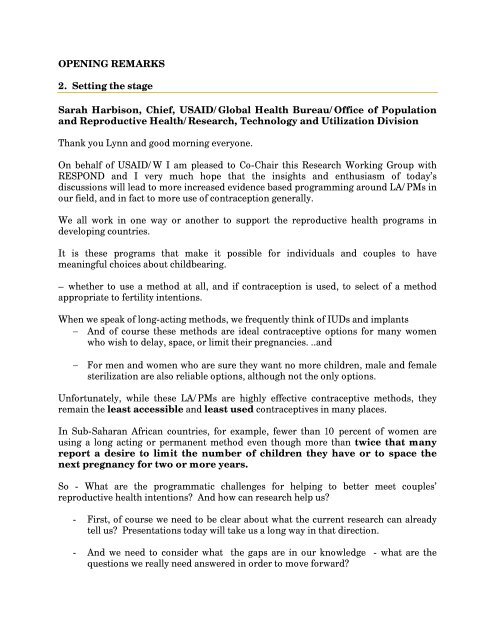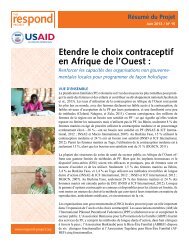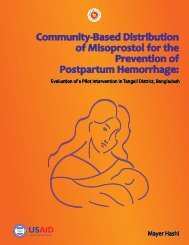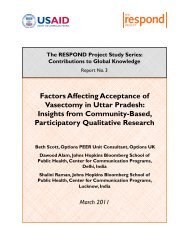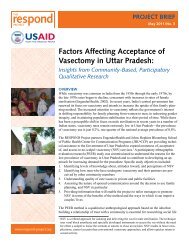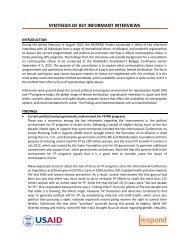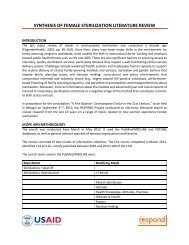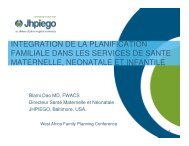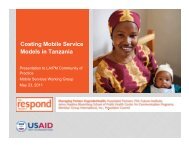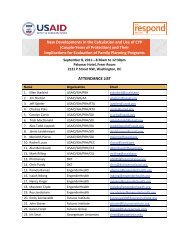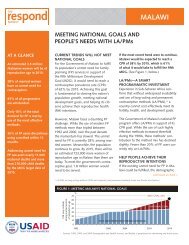Sarah Harbison - the RESPOND Project!
Sarah Harbison - the RESPOND Project!
Sarah Harbison - the RESPOND Project!
You also want an ePaper? Increase the reach of your titles
YUMPU automatically turns print PDFs into web optimized ePapers that Google loves.
OPENING REMARKS<br />
2. Setting <strong>the</strong> stage<br />
<strong>Sarah</strong> <strong>Harbison</strong>, Chief, USAID/Global Health Bureau/Office of Population<br />
and Reproductive Health/Research, Technology and Utilization Division<br />
Thank you Lynn and good morning everyone.<br />
On behalf of USAID/W I am pleased to Co-Chair this Research Working Group with<br />
<strong>RESPOND</strong> and I very much hope that <strong>the</strong> insights and enthusiasm of today’s<br />
discussions will lead to more increased evidence based programming around LA/PMs in<br />
our field, and in fact to more use of contraception generally.<br />
We all work in one way or ano<strong>the</strong>r to support <strong>the</strong> reproductive health programs in<br />
developing countries.<br />
It is <strong>the</strong>se programs that make it possible for individuals and couples to have<br />
meaningful choices about childbearing.<br />
– whe<strong>the</strong>r to use a method at all, and if contraception is used, to select of a method<br />
appropriate to fertility intentions.<br />
When we speak of long-acting methods, we frequently think of IUDs and implants<br />
And of course <strong>the</strong>se methods are ideal contraceptive options for many women<br />
who wish to delay, space, or limit <strong>the</strong>ir pregnancies. ..and<br />
For men and women who are sure <strong>the</strong>y want no more children, male and female<br />
sterilization are also reliable options, although not <strong>the</strong> only options.<br />
Unfortunately, while <strong>the</strong>se LA/PMs are highly effective contraceptive methods, <strong>the</strong>y<br />
remain <strong>the</strong> least accessible and least used contraceptives in many places.<br />
In Sub-Saharan African countries, for example, fewer than 10 percent of women are<br />
using a long acting or permanent method even though more than twice that many<br />
report a desire to limit <strong>the</strong> number of children <strong>the</strong>y have or to space <strong>the</strong><br />
next pregnancy for two or more years.<br />
So - What are <strong>the</strong> programmatic challenges for helping to better meet couples’<br />
reproductive health intentions? And how can research help us?<br />
- First, of course we need to be clear about what <strong>the</strong> current research can already<br />
tell us? Presentations today will take us a long way in that direction.<br />
- And we need to consider what <strong>the</strong> gaps are in our knowledge - what are <strong>the</strong><br />
questions we really need answered in order to move forward?
- Many of <strong>the</strong>se questions, I think, relate to <strong>the</strong> issues and barriers that couples<br />
face that are not being addressed by<br />
<strong>the</strong> service delivery programs or<br />
<strong>the</strong> methods that we currently have?<br />
As Lynn stressed, <strong>the</strong> LA/PM Research Working Group has been established to address<br />
precisely <strong>the</strong>se issues and to streng<strong>the</strong>n <strong>the</strong> links between LA/PM research and<br />
programs.<br />
We realize that o<strong>the</strong>r groups have similar agendas, and we certainly do not want to<br />
duplicate effort, so<br />
We have set aside some time at <strong>the</strong> end of <strong>the</strong> day for group discussions that will include<br />
a brainstorm about o<strong>the</strong>r groups that we can reach out to and with whom we can<br />
collaborate<br />
To be a little more specific, we hope that this group will facilitate that “two-way street:<br />
Increase <strong>the</strong> program/implementer input into <strong>the</strong> development of LA/PM<br />
research agendas , here I include<br />
Social science, programmatic (OR) and biomedical/technology research<br />
And in <strong>the</strong> o<strong>the</strong>r direction -Encourage <strong>the</strong> use of existing LA/PM research among<br />
programmers and policymakers.<br />
We hope that today’s technical session will be beneficial to you in a number of ways such<br />
as<br />
initiating discussions to inform future LA/PM research;<br />
exchanging preliminary research findings;<br />
developing action plans for research use; and<br />
establishing work planning linkages.<br />
We will begin our technical session with a presentation from Emily Sonnenveldt who is<br />
a Senior Associate at <strong>the</strong> Futures Institute. Emily will set <strong>the</strong> stage for us by presenting<br />
findings from a current secondary analysis of key LA/PM variables from DHS data sets<br />
in USAID PRH priority countries.<br />
The next two presentations will present results of current LA/PM research with a focus<br />
on applications for programming.<br />
Dr.Saumya Ramarao, Senior Associate at <strong>the</strong> Population Council, discuss long-acting<br />
FP methods, and<br />
And Dr. Maggwa, <strong>Project</strong> Director, PROGRESS <strong>Project</strong>/Family Health International<br />
will discuss permanent FP methods.<br />
We have allocated time for discussion and I will wrap up <strong>the</strong> session with some<br />
overarching <strong>the</strong>mes and implications from <strong>the</strong> USAID perspective. And with that, I turn<br />
it over to Emily Sonneveldt.


